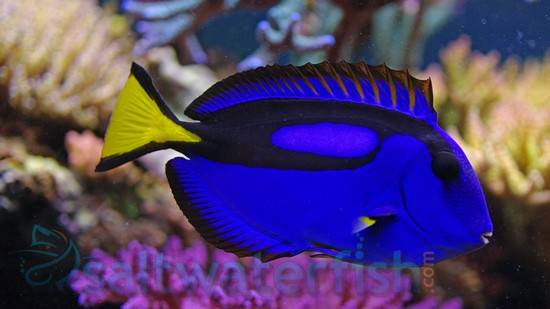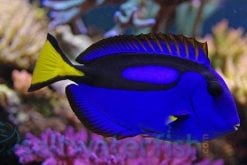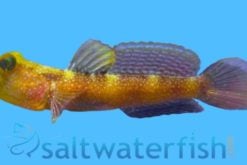Blue Hippo Tang (Paracanthurus hepatus)
Quick Stats:
- Care Level: Moderate
- Temperament: Semi-aggressive
- Diet: Herbivore
- Reef Safe: Yes
- Minimum Tank Size: 100 gallons
- Nature Max Size: 12 inches
- Water Parameters: pH 8.1-8.4, salinity 1.020-1.025, temperature 72-78°F
Comprehensive Guide: Blue Hippo Tang (Paracanthurus hepatus)
Habitat
The Blue Hippo Tang, also known as the Regal Tang or Palette Surgeonfish, is native to the Indo-Pacific region. They are commonly found in coral reefs, lagoons, and outer reef slopes. These fish prefer areas with abundant coral growth and clear water.
Reef Safe
The Blue Hippo Tang is generally considered reef safe. However, they may nip at corals, especially if not provided with enough algae and other vegetation in their diet. It is important to monitor their behavior and provide them with suitable food options to minimize any potential coral aggression.
Size
The Blue Hippo Tang can grow up to 12 inches in length, making it a relatively large fish for a home aquarium. It is important to provide them with a spacious tank to accommodate their size.
Temperament
The Blue Hippo Tang is known to be a semi-aggressive fish. They may exhibit territorial behavior, especially towards other tangs or similar-shaped fish. It is recommended to introduce them into the aquarium last or provide ample hiding spaces to minimize aggression.
Sexual Dimorphism
There are no distinguishable physical differences between male and female Blue Hippo Tangs.
Variations
Blue Hippo Tangs found in the Indian Ocean can have a regional variation of developing a yellow belly once matured. Despite the difference in coloration, they are the same species and have the same care requirements.
Lifespan
In proper aquarium conditions, the Blue Hippo Tang can live up to 10 years or more with proper care and maintenance.
Diet in Aquariums
The Blue Hippo Tang is a herbivorous fish that primarily feeds on various types of algae in the wild. In captivity, their diet should consist of a variety of dried seaweed, algae-based pellets, and live/frozen foods rich in vegetable matter. It is important to provide them with a balanced diet to maintain their health and vibrant coloration.
Aquascaping Recommendations
When setting up the aquarium for a Blue Hippo Tang, it is important to provide ample swimming space and hiding spots. Incorporating live rock structures and creating open areas will allow them to swim comfortably while also providing hiding places to reduce stress. Additionally, ensuring the presence of live rock will help promote natural grazing behavior.
Captive Bred Availability
The Blue Hippo Tang is not commonly available as a captive-bred species. Most specimens in the aquarium trade are wild-caught. However, efforts are being made to develop captive breeding programs for these fish to reduce the impact on wild populations.
Compatibility with Other Fish, Invertebrates, or Corals
The Blue Hippo Tang can be compatible with a variety of tankmates, but caution should be exercised when selecting companions. It is best to avoid keeping multiple tangs of similar size and shape together as they may become aggressive towards each other. Suitable tankmates for the Blue Hippo Tang include:
- Ocellaris Clownfish: These fish are peaceful and can add vibrant colors to the aquarium.
- Yellow Tang: They have a similar shape but are not aggressive towards Blue Hippo Tangs.
- Bicolor Blenny: These small, peaceful fish can add diversity to the tank.
- African Flameback Angelfish: They are relatively peaceful and can coexist with the Blue Hippo Tang.
- Green Mandarin Dragonet: These fish are non-aggressive and add a unique aesthetic to the aquarium.
Other Common Names
The Blue Hippo Tang is also commonly known as the Regal Tang, Palette Surgeonfish, Blue Surgeonfish, or Flagtail Surgeonfish.
Why Buy from Reefs4Less.com
Reefs4Less.com is a trusted online retailer that specializes in saltwater aquarium products. Their extensive selection, competitive prices, and commitment to customer satisfaction make them an ideal choice for purchasing fish and supplies. With a focus on quality and reliability, Reefs4Less.com ensures that customers receive healthy livestock and premium products for their aquarium needs.
Popular Questions and Answers
- Q: Can the Blue Hippo Tang be kept in a smaller tank?
A: While it is possible to keep a Blue Hippo Tang in a smaller tank temporarily, it is not recommended for long-term care. These fish require ample space to swim and thrive, so a minimum tank size of 100 gallons is recommended. - Q: Are Blue Hippo Tangs prone to any specific diseases?
A: Like many saltwater fish, Blue Hippo Tangs can be susceptible to various diseases, including ich and marine velvet. Proper quarantine procedures, regular water changes, and a balanced diet can help mitigate the risk of disease outbreaks. - Q: Can Blue Hippo Tangs be kept with aggressive tankmates?
A: It is generally not recommended to keep Blue Hippo Tangs with highly aggressive tankmates. They are best suited for aquariums with peaceful or semi-aggressive species to minimize potential conflicts. - Q: Do Blue Hippo Tangs require any special lighting?
A: Blue Hippo Tangs do not have specific lighting requirements. However, providing a suitable lighting spectrum that promotes the growth of algae and enhances the coloration of the fish can be beneficial. - Q: Can Blue Hippo Tangs change their sex in captivity?
A: No, Blue Hippo Tangs cannot change their sex. They are either male or female from birth and retain their gender throughout their lifespan.
| Size | 1.25 – 2 inches |
|---|




Reviews
There are no reviews yet.